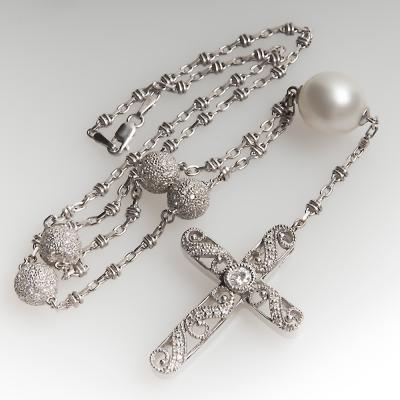
Posted in: World Wedding Customs
 Though not a traditional rosary, the style of this gorgeous cross necklace conjures notions of el lazo. El lazo is a Native Mexican wedding tradition incorporated in today's Roman Catholic wedding masses. Photo ©2019 EraGem Jewelry
Two Mexican wedding traditions endure from the ancient practices of Native Mexican Indians. Though both have evolved quite a bit since their original inception, these traditions maintain special significance for brides and grooms in Mexico.
Though not a traditional rosary, the style of this gorgeous cross necklace conjures notions of el lazo. El lazo is a Native Mexican wedding tradition incorporated in today's Roman Catholic wedding masses. Photo ©2019 EraGem Jewelry
Two Mexican wedding traditions endure from the ancient practices of Native Mexican Indians. Though both have evolved quite a bit since their original inception, these traditions maintain special significance for brides and grooms in Mexico.
Native Mexican Wedding Tradition: El Lazo
El lazo consists of a rope, cord, or long beaded rosary. As simple as a ribbon or as ornate as a jeweled double rosary, this cord symbolizes the unity of the couple. Los padrinos del lazo place the cord around the necks of the bride and groom in a figure-eight fashion. The couple wears this "lasso" resting across their shoulders for the remainder of the service. In Mayan culture, as well as in the subsequent Native Indian traditions, the lasso served to honor loved ones who could not be present for the ceremony. In addition, similar to the Hawaiian lei traditions, the cord served to welcome the newlyweds into the community in their new roles as husband and wife. (source) In rigid Catholic communities, el lazo now consists of a double rosary linked by a single cross which unites the couple in prayer under the singular headship of Christ.Native Mexican Wedding Tradition: Las Arras
Traditionally, las arras represented a year's worth of wages. Since each year has 13 moons, las arras included 13 valuable goods. At each moon during the first year of their marriage, the community offered newlyweds enough provision to ensure neither had to farm, hunt, or gather for the first year of their marriage. By removing the burden of provision, the newlyweds remained free to establish their family, most importantly by having a baby. Over the years, the custom evolved into a more symbolic ritual. In this form, los padrinos offered the couple 13 valuable items. Each item represents one of the moon's cycle in the first year of marriage. These goods included cacao beans, jade, and other small valuables which could be kept together in a small box as a symbol of their community's love and care for them. (source) Once Catholicism took root in Mexico, the church found a way to spiritualize the ritual for inclusion during the wedding mass. Today, the priest blesses an ornate box filled with 13 gold coins. The coins represent Christ and his 12 apostles. Today, the coins also symbolize the groom's willingness and ability to support his wife financially. Furthermore, as the groom hands over the box to his bride, the act represents the sharing of all their resources as equal partners in their marriage. As she takes the box from him, she offers her trust. Not only that, but she commits to steward their resources well. Of course, the box of coins remains a treasured family heirloom. It serves as a constant reminder of their trust in each other. I find the evolution of these ancient traditions so poignant. ~Angela Magnotti Andrews5 years ago
32 view(s) 